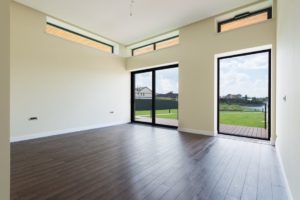
How to Choose Windows That Complement Your Home’s Architecture
When you’re considering window replacement or installation, it’s not just about the quality and features of the windows themselves; it’s also about how they’ll fit with the overall aesthetic of your home. Windows are an integral part of your home’s character and can either enhance or undermine the architectural style you love. Here’s how to ensure your new windows are in harmony with your home’s architecture.
Understand Your Home’s Architectural Style
Every home has a story and a style. Whether it’s a classic Victorian, a cozy Craftsman, or a modern minimalist design, identifying your home’s architectural style is the first step. Research homes similar to yours and note the types of windows that are commonly used. Historical homes might benefit from classic wood-framed, single-pane windows, while contemporary homes might look best with larger, fixed-pane windows with minimal frames.
Why Architectural Style Matters:
The architectural style of a home is its fingerprint, a unique blend of design elements, structure, and historical context. Windows are one of the most prominent features of a home’s exterior and have the power to dictate its personality. Choosing windows without considering the architectural style is akin to picking a hat without regard to the shape of your face—it might not complement the overall look.
Impact on Window Choice:
The architectural style can significantly influence the type, shape, material, and design of the windows you choose:
- Traditional Styles (Colonial, Victorian, Cape Cod): These homes often feature symmetrically placed double-hung windows with grids or divided lights that add a classic, structured appearance. Wooden frames or those with a wood-like finish are common choices that respect the integrity of these historical designs.
- Modern and Contemporary Styles: These homes tend to emphasize clean lines and unobstructed views, often with large, fixed-pane windows or casements with minimal framing. Materials like aluminum or vinyl, known for their sleek finishes, complement the modern aesthetic.
- Craftsman Style: Characterized by handcrafted simplicity and natural materials, Craftsman homes often incorporate windows with stained glass, grilles, or a grid system in a bungalow-style layout. Wooden frames stained to showcase the natural grain are a hallmark of this style.
- Ranch Style: Ranch homes typically have wide layouts and may feature large picture windows combined with smaller, operable windows for ventilation. The emphasis is on practicality and ease of access, with a preference for low-maintenance materials.

Understanding your home’s architectural style isn’t just about maintaining aesthetic coherence; it’s about respecting the narrative of your home’s design. The right windows act like the eyes of the home, not just in how they allow you to view the world, but in how they reflect the home’s character and history. The best window choice enhances the living experience both from within and without, merging style with function in a way that feels both timeless and timely.
Proportion and Scale
Windows should be in proportion to the size of your walls and the scale of your home. Large, expansive glass might be out of place on a small cottage but could be perfect for a modern abode. Similarly, small, intricate windows can add charm to a Victorian home but could look busy and fussy on a clean, contemporary design.
Proportion and scale are fundamental elements in the architectural lexicon, dictating the balance and harmony of a home’s aesthetic. When it comes to windows, these principles ensure that the windows not only fit the size of the wall spaces available but also look as though they were intended for the home from the outset.
Proportional Fit:
A window’s proportion refers to the relationship between its dimensions—height, width, and depth—and those of the surrounding space. A well-proportioned window looks like it belongs; it’s neither overbearing nor insignificant. It complements the size of the wall and roof pitch, aligns with other windows, and respects the home’s overall scale.
Scale and Architectural Harmony:
Scale involves the size of the windows in relation to the size of the house. Large, expansive windows can make a small house seem out of scale, while small windows can be lost on a large expanse of wall. The right scale helps maintain the architectural integrity of the home.
Achieving Balance with Proportion and Scale:
- Visual Alignment: Windows should align with key architectural features such as doors, gables, and other windows to create visual symmetry.
- Consider the View and Orientation: Proportion and scale aren’t just about the window itself but also about the interface between the interior and exterior. The size and placement of a window should take into account the views it will frame and its orientation for light and warmth.
- Functional Aspect: The scale also has a practical side. Larger windows may bring in more light but could also affect energy efficiency. Consider the trade-offs and choose a size that balances aesthetic desires with functional needs.

Design Consistency:
- Repeating Elements: A consistent design element, such as a particular window style or grille pattern, can help unify the home’s appearance, even if the window sizes vary.
- Grouping Windows: If larger windows are not suitable, consider grouping smaller windows together to achieve a sense of scale without overwhelming the space.
Custom Solutions:
Sometimes, off-the-shelf window sizes and styles won’t align with the unique proportions and scale of your home. In such cases, custom windows become a worthwhile investment, allowing for design flexibility and a perfect architectural fit.
Complementary Materials
The materials you choose for your window frames should complement the rest of your home’s construction materials. Wood frames may be ideal for traditional homes, while aluminum or vinyl might suit modern aesthetics. The finish and color should also be in line with the rest of your home’s exterior features.
Selecting the right material for your windows is not just a matter of durability and maintenance; it is also crucial for complementing your home’s architectural style and enhancing its overall character. The material of a window frames not only the view but also the aesthetic sensibility of the structure.
Harmonizing with Home Architecture:
- Traditional Styles: For homes with a more traditional or historical architecture, such as Victorian, Colonial, or Craftsman styles, wood frames are often preferred. Wood offers a classic look that can be painted or stained to match the home’s trim, contributing to the historic authenticity of the style.
- Modern and Contemporary Homes: For modern homes that feature clean lines and a minimalist aesthetic, materials like aluminum or vinyl offer a sleek, low-profile look. They can be designed with a thinner frame, allowing for a larger pane of glass that showcases a modern design’s emphasis on natural light and outdoor connections.

Energy Efficiency and Material Choice:
- Insulative Properties: Material choice also affects the thermal properties of a window. Wood and vinyl are natural insulators, which can help reduce heat transfer. For those in harsher climates, fiberglass frames, which resist temperature-induced expansion and contraction, might be the best option for maintaining energy efficiency.
- Composite Materials: Some windows incorporate composite materials, which blend wood fibers and plastic polymers for enhanced durability and thermal performance. Composites can be an excellent choice for homeowners who want the look of wood without as much maintenance.
Aesthetic Integration:
- Finish and Color: Material is also about finish and color. Choosing a window frame material that can be customized to match or complement your home’s color palette is vital for visual harmony.
- Texture and Detailing: The texture of the material can add depth and interest to your home’s facade. For example, the natural grain of wood can add richness and warmth, while the smooth finish of vinyl or aluminum can complement a more modern aesthetic.
Reflect the Era
Vintage homes often have window styles that are indicative of the period they were built in. You might choose to replicate these to maintain authenticity. For newer homes, you might opt for windows that offer a nod to the past with divided light bars, or you could go with something that leans toward future trends with minimalist designs.
Echoing Historical Authenticity:
The windows of a home are more than mere portals to the outside world; they are a reflection of the period in which the house was constructed or the architectural style it emulates. For homeowners, understanding the era of their home is pivotal in choosing windows that not only match but also celebrate the architectural heritage.
Significance of Period-accurate Windows:
- Character Preservation: Windows designed in the style of the home’s era preserve its character. For instance, a Victorian home might feature bay windows with decorative panes, while a mid-century modern might showcase large, fixed-pane windows with minimal framing.
- Resale Value: Homes with period-accurate windows often fare better in the real estate market. They appeal to buyers looking for homes with authentic charm and historical integrity.

Understanding the Architectural Language:
- Design Cues: Each era has its design cues. For example, the Art Deco period favored geometric patterns, while the Renaissance era preferred symmetry and proportion. Windows that mimic these details contribute to a cohesive architectural language.
- Custom Elements: Sometimes, this might mean custom elements or specialized glasswork, which can be a worthwhile investment to maintain the home’s unique architectural narrative.
Integrating Modern Efficiency:
- Technological Advances: Fortunately, advancements in window technology allow homeowners to install windows that are aesthetically period-appropriate but come with modern benefits. These include improved energy efficiency, sound insulation, and UV protection.
- Historical Considerations: For historic homes, it’s important to balance authenticity with practicality. While maintaining the historical look is key, one should not forgo the benefits of modern window technology. Homeowners can often find manufacturers that offer historically styled profiles with high-performance glazing options.
Choosing windows that reflect the era of your home requires a balance between aesthetic, historical accuracy, and modern performance. Whether restoring a classic bungalow or customizing a new build to reflect a bygone era, the windows should be a testament to the time period’s architectural vision while still providing the comfort and efficiency of the modern age. By doing so, homeowners can ensure that their home not only stands as a tribute to the past but is also fit for the present and the future.
Symmetry vs. Asymmetry
Look at your home’s façade. Is it symmetrical or asymmetrical? The arrangement of windows should reflect this. Symmetrical façades, often found in Colonial-style homes, call for a balanced window setup. More eclectic styles like Victorian or some modern designs can handle asymmetrical window configurations without losing their appeal.
Light and Functionality
Beyond aesthetics, consider how your window choice will affect the light and functionality of your home’s interior. Bay or bow windows can add extra space and light, picture windows can offer expansive views, and operable windows like casements or double-hung can provide ventilation where needed.
Energy Efficiency and Comfort
Modern windows come with a variety of energy-efficient features that can improve comfort and reduce energy bills, without compromising style. Look for double or triple-glazing, low-E coatings, and inert gas fills to provide insulation. Make sure these features are suitable for your climate and the orientation of your home.
When selecting windows that are in harmony with your home’s architectural style, considering energy efficiency and comfort is crucial. These elements serve as the bridge between your home’s aesthetic appeal and its functionality, impacting not only the environment but also your utility bills and comfort levels throughout the seasons.

Energy Efficiency: A Dual Purpose
Energy-efficient windows are designed to keep the external weather out while maintaining the desired internal temperatures. This dual purpose is key for homes in regions with extreme weather patterns, be it the icy chill of winter or the scorching heat of summer.
The Role of High-Performance Windows:
Modern windows come equipped with features such as double or triple glazing, inert gas fills, and low-E coatings. These enhancements drastically reduce heat transfer, making your home warmer in the winter and cooler in the summer without over-reliance on heating and cooling systems.
Comfort Beyond Temperature:
Comfort isn’t solely about maintaining a steady temperature. It’s also about the quality of the indoor environment, which includes factors such as natural light, air flow, and noise reduction. Energy-efficient windows can help manage all these aspects, making your home a more pleasant place to live.
UV Protection:
High-performance windows can also offer protection against UV radiation, which not only protects occupants from harmful sun exposure but also prevents fading of furniture, curtains, and carpets.
Sealing Against the Elements:
A well-chosen window will come with proper sealing and weatherstripping, keeping out drafts and moisture that can lead to mold and mildew. This ensures the window’s longevity and the home’s structural integrity.
Financial Incentives:
Many energy-efficient windows qualify for tax credits or rebates, providing an additional financial incentive for making the environmentally friendly choice.
Personalized Choices:
Homeowners can now select from a variety of energy-efficient window options that suit their home’s architectural style without compromising on the historical aesthetics. For example, you can opt for windows with advanced glazing that mimics the wavy glass look of antique windows or frames that replicate the traditional wood joinery.

Consult with a Professional
When in doubt, consult with a window installation professional or an architect. They can provide valuable insight into the types of windows that will best match your home’s architectural style and offer functionality tailored to your needs.
Selecting new windows is a significant decision that affects both the look and the feel of your home. With the right choices, you can enhance your home’s architectural beauty and boost its curb appeal. Remember, windows are not just about seeing out; they’re about looking in, and they should be as pleasing from the curb as they are from your couch.
Choosing windows that enhance your home’s architecture is an art as much as a science. When it’s time to replace your windows or if you’re building from scratch, keep these guidelines in mind to ensure that your new windows are a perfect complement to your home’s unique style. If you find yourself in need of guidance or ready for installation, we are ready to help you get connected to competitive quotes and professional advice to make the best choice for your architectural jewel!
Compare Prices

Leave a Reply